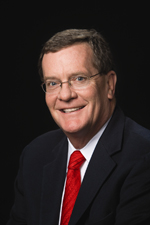Tim Solso
Share
Chairman and CEO, Cummins

Tim Solso joined Cummins Inc. in 1971 and has been Chairman and Chief Executive Officer since January 2000. Prior to his current role, he served as President and Chief Operating Officer from 1995-2000 and as Vice President – Engine Business from 1988-1995.
Under his leadership, Cummins has grown into a Fortune 250 company that designs, produces and sells diesel engines, power generation equipment and related components worldwide. The Company currently does business in more than 190 countries and territories and in 2008 recorded its fifth straight year of record financial results, with more than $14 billion in sales and $755 million in net income.
Mr. Solso, 64, serves as Chairman of Cummins Foundation, one of the oldest corporate foundations in the country, which is focused on supporting environmental, educational and social justice initiatives in the communities where Cummins operates. He also currently holds leadership roles at a number of other companies, business organizations and philanthropic endeavors.
He is the U.S. Chairman of the U.S. – Brazil CEO Forum, a member of the Board of Ball Corp., Ashland Inc., the American Transportation Research Institute and is a member of the Business Roundtable. He also serves on the Board of the Initiative for Global Development, Earth University and the Earth University Foundation.
Among his recent honors, in March 2011 Mr. Solso was appointed to serve as a member of President Barack Obama’s Management Advisory Board. The Board was established by Executive Order in 2010 to provide advice on how to implement best business practices in the federal government’s management and operation.
In 2010 and 2011, he was named a top five finalist to Marketwatch’s CEO of the Decade and to Barron’s list of the 30 Most Respected CEOs for 2010. He was awarded the William R. Laws Human Rights Award by the Human Rights Commission of Columbus, IN, where Cummins is headquartered, in 2009 and the Ellis Island Medal of Honor in 2008. In 2007, he was selected as the national Six Sigma CEO of the year and was selected to receive the Anti-Defamation League’s Man of Achievement Award. That same year he was named the International Executive of the Year by the Academy of International Business and received the American Business Award for Best Chairman.[/learn_more]
[learn_more caption=”Statement on Public-Private R&D Partnerships”]Consistently innovating in energy technology requires pairing top engineering talent with world-class research and development facilities and expertise. Public-private partnerships play an essential role. Well structured partnerships accelerate the development of new and improved technologies, including the clean engines and components built at Cummins.
For instance, Cummins currently is partnering with several private firms - including PACCAR Inc., Eaton Corporation and VanDyne SuperTurbo Inc. - and Oak Ridge National Laboratory and Purdue University - on a project under the Department of Energy’s SuperTruck program to significantly improve freight efficiency.
The SuperTruck program combines public and private expertise and resources to advance fuel efficiency technology for Class 8 tractor trailers. The goal is to make significant efficiency gains and provide real fossil-fuel savings by fostering innovative advances in diesel engines, cab and trailer aerodynamics and engine idle management. This will be accomplished through a comprehensive, system-based approach.
Cummins and its partners received a $39 million award from the DOE under this program and are matching these funds dollar for dollar - an example of how public resources attract private sector investment and participation. When the technologies developed under the project are fully deployed, the engine efficiency improvements alone are projected to reduce fuel consumption for on-road heavy trucks by over 20 percent. Over 5 years, the fleet would see a reduction of more than 73 million tons of CO2 - equivalent to converting 13 million passenger cars to zero emissions. This initiative demonstrates how DOE brings public and private entities together and incents them to deliver innovative technology results.
Government and the private sector successfully work together through such thoughtfully crafted public-private partnerships, and these initiatives should be expanded going forward.